
-
 Afrikaans
Afrikaans -
 Albanian
Albanian -
 Amharic
Amharic -
 Arabic
Arabic -
 Armenian
Armenian -
 Azerbaijani
Azerbaijani -
 Basque
Basque -
 Belarusian
Belarusian -
 Bengali
Bengali -
 Bosnian
Bosnian -
 Bulgarian
Bulgarian -
 Catalan
Catalan -
 Cebuano
Cebuano -
 China
China -
 China (Taiwan)
China (Taiwan) -
 Corsican
Corsican -
 Croatian
Croatian -
 Czech
Czech -
 Danish
Danish -
 Dutch
Dutch -
 English
English -
 Esperanto
Esperanto -
 Estonian
Estonian -
 Finnish
Finnish -
 French
French -
 Frisian
Frisian -
 Galician
Galician -
 Georgian
Georgian -
 German
German -
 Greek
Greek -
 Gujarati
Gujarati -
 Haitian Creole
Haitian Creole -
 hausa
hausa -
 hawaiian
hawaiian -
 Hebrew
Hebrew -
 Hindi
Hindi -
 Miao
Miao -
 Hungarian
Hungarian -
 Icelandic
Icelandic -
 igbo
igbo -
 Indonesian
Indonesian -
 irish
irish -
 Italian
Italian -
 Japanese
Japanese -
 Javanese
Javanese -
 Kannada
Kannada -
 kazakh
kazakh -
 Khmer
Khmer -
 Rwandese
Rwandese -
 Korean
Korean -
 Kurdish
Kurdish -
 Kyrgyz
Kyrgyz -
 Lao
Lao -
 Latin
Latin -
 Latvian
Latvian -
 Lithuanian
Lithuanian -
 Luxembourgish
Luxembourgish -
 Macedonian
Macedonian -
 Malgashi
Malgashi -
 Malay
Malay -
 Malayalam
Malayalam -
 Maltese
Maltese -
 Maori
Maori -
 Marathi
Marathi -
 Mongolian
Mongolian -
 Myanmar
Myanmar -
 Nepali
Nepali -
 Norwegian
Norwegian -
 Norwegian
Norwegian -
 Occitan
Occitan -
 Pashto
Pashto -
 Persian
Persian -
 Polish
Polish -
 Portuguese
Portuguese -
 Punjabi
Punjabi -
 Romanian
Romanian -
 Russian
Russian -
 Samoan
Samoan -
 Scottish Gaelic
Scottish Gaelic -
 Serbian
Serbian -
 Sesotho
Sesotho -
 Shona
Shona -
 Sindhi
Sindhi -
 Sinhala
Sinhala -
 Slovak
Slovak -
 Slovenian
Slovenian -
 Somali
Somali -
 Spanish
Spanish -
 Sundanese
Sundanese -
 Swahili
Swahili -
 Swedish
Swedish -
 Tagalog
Tagalog -
 Tajik
Tajik -
 Tamil
Tamil -
 Tatar
Tatar -
 Telugu
Telugu -
 Thai
Thai -
 Turkish
Turkish -
 Turkmen
Turkmen -
 Ukrainian
Ukrainian -
 Urdu
Urdu -
 Uighur
Uighur -
 Uzbek
Uzbek -
 Vietnamese
Vietnamese -
 Welsh
Welsh -
 Bantu
Bantu -
 Yiddish
Yiddish -
 Yoruba
Yoruba -
 Zulu
Zulu
fiberglass clarifier system
Understanding the Fiberglass Clarifier System A Comprehensive Overview
In the world of water treatment, efficiency and durability are paramount. One such innovation that exemplifies these qualities is the fiberglass clarifier system. This technology plays a crucial role in clarifying wastewater and improving the overall quality of effluent, making it suitable for various industrial applications. This article explores the structure, benefits, and applications of fiberglass clarifier systems, emphasizing why they are increasingly becoming a preferred choice for water treatment processes.
What is a Fiberglass Clarifier System?
A fiberglass clarifier system is a water treatment mechanism designed to remove suspended solids and other impurities from wastewater. The core of this system is the clarifier tank, which is constructed from fiberglass-reinforced plastic (FRP). This material is chosen for its lightweight, corrosion-resistant, and long-lasting properties, which are essential for systems that are often exposed to harsh chemical environments and varying temperatures.
The operation of the clarifier itself is based on the principle of sedimentation. Wastewater is introduced into the clarifier, allowing heavier solid particles to settle at the bottom while the cleaner water rises to the surface. This process effectively separates solids from liquid, leading to a significant reduction in turbidity and improved water quality.
Benefits of Fiberglass Clarifier Systems
1. Durability and Corrosion Resistance Fiberglass is inherently resistant to corrosion, unlike traditional materials such as steel or concrete, which can deteriorate over time when exposed to water and chemicals. This resilience extends the lifespan of the clarifier system, reducing the need for frequent replacements and repairs.
2. Lightweight Construction The lightweight nature of fiberglass facilitates easier installation and handling. Compared to metal or concrete systems, fiberglass clarifiers can be transported and installed with less effort and require less structural support.
3. Cost-Effectiveness While the initial investment for a fiberglass clarifier system may be higher than other materials, the long-term savings from reduced maintenance and repair costs make it a cost-effective option. The durability of fiberglass systems leads to fewer disruptions, enhancing operational efficiency.
4. Customization Fiberglass clarifiers can be customized to meet specific treatment needs and site conditions. The design and size can be tailored to accommodate varying flow rates and types of wastewater, making them adaptable for a range of industrial applications.
fiberglass clarifier system

5. Ease of Maintenance The smooth surface of fiberglass inhibits the buildup of sludge and biological growth, making cleaning and maintenance more manageable. This feature is crucial for maintaining optimal performance and ensuring compliance with environmental regulations.
Applications of Fiberglass Clarifier Systems
Fiberglass clarifier systems have found widespread application across various sectors, including
- Municipal Wastewater Treatment These systems help municipalities effectively treat sewage and wastewater before it is released back into the environment or recycled for other uses. - Industrial Wastewater Management Many industries, such as food processing, pulp and paper, and chemicals, rely on fiberglass clarifiers to handle wastewater laden with solids and other contaminants.
- Stormwater Management In areas where stormwater runoff is a concern, fiberglass clarifiers can be employed to treat runoff water, helping to prevent pollution and protect water quality in nearby bodies of water.
- Mining Operations The mining industry often produces significant amounts of wastewater that require effective treatment; fiberglass clarifiers can manage and clarify this effluent efficiently.
Conclusion
The fiberglass clarifier system stands as a testament to the advancements in water treatment technology. With its combination of durability, cost-effectiveness, and versatility, this system is transforming the way industries approach wastewater management. As environmental regulations become more stringent, and the demand for clean water grows, investing in reliable and efficient treatment systems like fiberglass clarifiers will be crucial for businesses aiming to ensure compliance and sustainability.
In summary, the future of water treatment is bright, and fiberglass clarifier systems are at the forefront of this evolution, providing solutions that not only protect our environment but also support the operational needs of various industries. This innovative approach to wastewater treatment is a key step toward achieving cleaner, healthier water resources for future generations.









